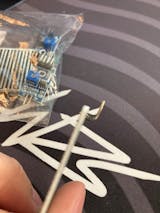Rain Drop Detection Sensor Module Raindrops Humidity Weather Sensor


Raindrops Detection Sensor Module Rain Weather Module for Arduino, etc. Rain sensor can be used to monitor a variety of weather conditions and turned into several fixed output signal and Analog output.
It includes a printed circuit board (control board) that “collects” the raindrops. As raindrops are collected on the circuit board, they create paths of parallel resistance that are measured via the op-amp. The lower the resistance (or the more water), the lower the voltage output. Conversely, the less water, the greater the output voltage on the analog pin. A completely dry board, for example, will cause the module to output 5V.
The module includes a rain board and a control board that is separate for more convenience. It has a power indicator LED and an adjustable sensitivity through a potentiometer. The module is based on the LM393 op-amp.


Rain Drop Detection Sensor Module Raindrops Humidity Weather Sensor
Available:In Stock
- Product SKU: KG004
₹ 48
₹ 59
Need Volume Discounts? Deals are specially designed for you. Click here
Need Customization? Provide us more details Click here
Warehouse Details


Specification
Description
Rain Drop Detection Sensor Module Raindrops Humidity Weather Sensor
The Raindrops Detection sensor module is used for rain detection. It is also for measuring rainfall intensity. Rain sensor can be used for all kinds of weather monitoring and translated into output signals and AO.Raindrops Detection Sensor Module Rain Weather Module for Arduino, etc. Rain sensor can be used to monitor a variety of weather conditions and turned into several fixed output signal and Analog output.
It includes a printed circuit board (control board) that “collects” the raindrops. As raindrops are collected on the circuit board, they create paths of parallel resistance that are measured via the op-amp. The lower the resistance (or the more water), the lower the voltage output. Conversely, the less water, the greater the output voltage on the analog pin. A completely dry board, for example, will cause the module to output 5V.
The module includes a rain board and a control board that is separate for more convenience. It has a power indicator LED and an adjustable sensitivity through a potentiometer. The module is based on the LM393 op-amp.
Technical Details
- Item Type: Sensor
- Model Type: Rain Detection Sensor
- Voltage Rating: 3.3V - 5V
- Driver Size: 32x15x9mm (LxWxH)
- Board Size: 54x40x1.5mm (LxWxH)
Features
- LM393 Wide Voltage Comparator
- Digital and Analog Output
- LED Output Indicator
- Compatible with Arduino and TTL
- High-Quality FR-04 Double-Sided Material (5.5 x 4.0 cm)
- Nickel-Plated Surface for Oxidation Resistance and High Conductivity
- Strong Driving Ability: >15mA
- Adjustable Sensitivity via Potentiometer
- Output: Digital (0/1) and Analog (AO Voltage)
- Fixed Bolt Hole for Easy Installation
Pin Description:
- VCC: 3.3 Volts to 5 Volts
- GND: Power Supply Ground
- AOUT (Analog Sensor Output): Arduino/MCU Input
- DOUT (Digital Sensor Output): Arduino/MCU Input
Applications :
- Weather Monitoring: Detects rainfall for weather stations.
- Smart Irrigation Systems: Pauses watering during rain to conserve water.
- Automotive Systems: Activates automatic windshield wipers.
- Home Automation: Closes windows or covers during rain.
- Agriculture: Monitors rain to adjust irrigation schedules.
- Disaster Management: Tracks rainfall for flood prediction.
- IoT Projects: Integrates with weather-based smart devices.
- Outdoor Equipment Protection: Alerts for rain to safeguard sensitive equipment.
- Industrial Applications: Monitors rain for outdoor machinery operations.
- DIY Electronics: Used in hobby projects for weather sensing.
Integration with Arduino

Sample Code
Integration with Raspberry Pi

Sample Code
Physical Attributes
- Driver Size: 32x15x9mm (LxWxH)
- Board Size: 54x40x1.5mm (LxWxH)
- Cable Length: Approx.21cm.
- Weight (gm): 10
Package Includes
- 1 x Printed Circuit Board for Rain Water Collection
- 1 x Control Board with LM393 Voltage Comparator
- 1 x 2-Wire Dupont Cable F to F



























